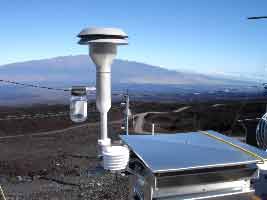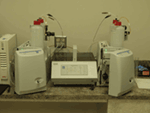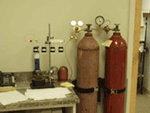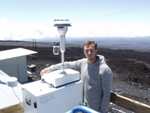More than two years after road access and electrical power to the Mauna Loa Observatory was cut off by lava flows, NOAA staff continue to make critical measurements of the atmosphere and other environmental variables at the remote site.
In 2023, observatory staff installed solar panels at the site and resumed some measurements, including the independent carbon dioxide monitoring programs run by the Global Monitoring Laboratory and Scripps Institution of Oceanography, as well as other atmospheric measurements.
Construction of a temporary road to access the observatory site is anticipated to begin in summer 2025.
Media can contact: Theo Stein (303) 819-7409 (theo.stein@noaa.gov)
Organization(s):
 US Environmental Protection Agency (EPA) / National Exposure Research Laboratories (NERL) / Human Exposure and Atmospheric Sciences Division (HEASD)
US Environmental Protection Agency (EPA) / National Exposure Research Laboratories (NERL) / Human Exposure and Atmospheric Sciences Division (HEASD)
What does this program measure?
The EPA Sequential Fine Particle Sampler is a gaseous sampler that tests for metals and compounds in the air. It collects cations of Lithium, Sodium, Ammonium, Potassium, Magnesium, and Calcium and anions of Fluoride, Chloride, Nitrite, Bromide, Nitrate, Phosphate, and Sulfate.
How does this program work?
A URG automated sequential fine particle sampler (SFPS) collection system capable of collecting a minimum of seven days of gas and particulate samples without operator assistance. EPA-approved 47mm Teflon filters with unique identification numbers are stamped on the polypropylene support ring, and 242 mm multi-channel annular denuders are prepared, sampled, and analyzed in a manner consistent with EPA method IO-4. The filters are extracted in 5 ml of deionized water in a glove bag. The filter extract is introduced into a DIONEX ICS-90 ion chromatographic system for the quantification of major anions and cations. (e.g. halides).
Why is this research important?
The objective is to accumulate a long-term record of gas and fine (<2.5 µm) particulate halide chemistry to support atmospheric mercury chemistry research.

(top section of SFPS, facing Mauna Kea)
Are there any trends in the data?
How does this program fit into the big picture?
What is it's role in global climate change?
Comments and References
Lead Investigator(s):
Dr Matthew S. Landis
919-541-4841
MLO Contact(s):
Aidan Colton
808-933-6965 (x233)
Alan M Yoshinaga
808-933-6965
Web Site(s)
Date Started
May 29, 2003
Related Programs
EPA Aethalometer
EPA Mercury Monitoring
EPA Mercury Precipitation
EPA Ambient Ion Monitor
EPA Dichotomous Partisol
EPA Sulfur Dioxoide
EPA Surface Ozone




